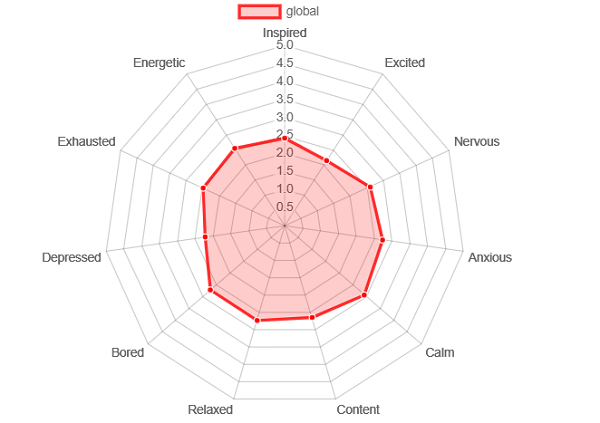Featured
Mapping the Moods of COVID-19: Global Study Uses Data Visualization to Track Psychological Responses, Identify Targets for Intervention

In March 2020, the fast-spreading coronavirus prompted many countries to go into lockdown and to take other behavioral measures to flatten the epidemic curve. People’s adherence to these containment guidelines involve acceptance of social norms, trust in authority, and personal sacrifice. Such adherence is challenged by the deprivation of material and psychological needs that such measures entail, along with the resulting accumulation of psychological strain (Brooks et al., 2020). Various psychological influences could also work against effective containment of the virus (Van Bavel et al., 2020). Hence, social science is critical for understanding responses to COVID-19 and the progression of the pandemic, especially in the event of a long-term or recurring virus containment scenario.
Sensing the urgency of the challenge, a collaboration of 100+ researchers across five continents launched a global study to investigate the psychological implications of this crisis, including the tensions between following government policy and meeting the basic needs of autonomy and social connection. We launched the PsyCorona survey on March 19th, 2020; by the end of May, more than 60,000 participants had completed the initial, 20-minute survey in 30 languages globally, which included 24 nationally representative samples by age and gender.

Real-Time Country-Level Data
PsyCorona’s rapid implementation and global scale affords us the ability to investigate different psychological processes during this critical moment of societal crisis and change. The ongoing scientific mission is to integrate cross-cultural, longitudinal, and integrative data science methods to:
- Evaluate how COVID-19-relevant beliefs, fears, hopes, motivational states, and cultural norms predict adherence to social distancing and other health guidelines;
- Monitor various psychological pressures building in society over time, including frustration and lockdown fatigue, changes in subjective well-being, and shifts in norms, attitudes, and values; and
- Integrate the psychological data with interdisciplinary databases, and use machine learning models to test how our individual-level psychological variables relate to regional epidemiological, policy, and demographic conditions.
Alongside this scientific mission is a crisis-oriented mission to provide information relevant to the present pandemic. Given that the academic publication process can be slow, we sought to provide a more immediate way to access portions of the data. Thus, we built a secure, anonymous, web-based data visualization tool where visitors can easily examine descriptive statistics and associations among study variables. While PsyCorona researchers prepare scientific papers for peer review (e.g., Han et al., 2020; Nisa et al., 2020; Romano et al., 2020), visitors are welcome to interact directly with country-level data in a manner consistent with the urgency of the times.

The purpose of this data visualization tool is twofold.
First, it gives our respondents immediate access to the research they participated in by allowing them to interact with the summary data (e.g., Van der Krieke et al., 2016); in effect, it serves as a pilot study for how the social sciences can use data visualization for public engagement.
Second, the data visualization tool serves as a resource for researchers, policymakers, and analysts to understand how people are feeling, thinking, and responding to the coronavirus and the extraordinary societal measures taken against it in their country (or across different countries). Such knowledge could help to inform strategies to further contain the pandemic as well as to better coordinate and prepare for future similar events.
As a resource for researchers, policymakers, and analysts, PsyCorona could help to inform strategies to further contain the pandemic as well as to better coordinate and prepare for future similar events.
A version of the tool (currently, an interactive public beta) can accessed via our project website (https://psycorona.org/data/). It focuses exclusively on the cross-sectional and cross-national data. Users can examine mean differences and associations between multiple categories of psychological variables, including virus-relevant beliefs and attitudes, emotions and affect, attitudes towards government and society, and self-reported behaviors. These variables and others can also be plotted against each other to visualize their relationships. Users can also examine and compare different psychological variables within one country, across multiple countries, or view global averages and trends. In the finalized version (expected late this summer), users will be able to toggle between viewing the full sample or only the nationally representative samples, and will also be able to toggle between examining raw scores or scores that are adjusted for potential cultural response biases (Gelfand et al., 2002).
The functionality of the data visualization tool is enhanced by the Data Science Team at the University of Groningen’s Center of Information and Technology. One plan is to monitor effects over time through the integration of our weekly longitudinal follow-up survey data. Resources permitting, we also aim to add state-of-the-art machine learning functions to, for example, identify the strongest psychological predictors of a given outcome variable. A third possibility is to add interdisciplinary database integration functions, so that visitors can explore how regional epidemiological or policy conditions relate to our measured variables.
As with much of the PsyCorona project, the data visualization tool is still in progress and its final outcome remains to be seen. In the meantime, it offers a glimpse into a possible future of social science that is publicly accessible, responsive to public need, and in which scientific data are communicated in a way that lets users ask their own questions.
References
Brooks, S. K., Webster, R.K., Smith, L. E., Woodland, L., Wessely, S., Greenberg, N. et al. (2020). The psychological impact of quarantine and how to reduce it: rapid review of the evidence. Lancet, 395, 912-920. 10.1016/S0140-6736(20)30460-8
Gelfand, M. J., Raver, J. L., & Ehrhart, K. H. (2002). Methodological issues in cross-cultural organizational research. Handbook of industrial and organizational psychology research methods, 216-241.
Han, Q., et al., (2020, June 29). Trust in government and its associations with health behaviour and prosocial behaviour during the COVID-19 pandemic. https://doi.org/10.31234/osf.io/p5gns
Krieke, L. V. D., Jeronimus, B. F., Blaauw, F. J., Wanders, R. B., Emerencia, A. C., Schenk, H. M., … & Bos, E. H. (2016). HowNutsAreTheDutch (HoeGekIsNL): A crowdsourcing study of mental symptoms and strengths. International journal of methods in psychiatric research, 25(2), 123-144. https://doi.org/10.1002/mpr.1495
Nisa, C. F., et al. (2020, submitted). Perceived economic risk (vs. health risk) motivates individual efforts to fight COVID-19: A multilevel analysis in 24 countries.
Romano, A., et al. (2020, submitted). Cooperation and Trust Across Societies During the COVID-19 Pandemic.
Van Bavel, J.J., et al. (2020) Using social and behavioural science to support COVID-19 pandemic response. Nature Human Behavior. https://doi.org/10.1038/s41562-020-0884-z
About the authors: Pontus Leander is an associate professor of psychology, University of Groningen, and is co-director of PsyCorona (psycorona.org). Jannis Kreienkamp and Maximilian Agostini are PhD students in the Department of Psychology, University of Groningen; they are co-founders of PsyCorona and designed the data visualization tool.
Scientific team: Jocelyn J. Bélanger (co-director), Ben Gützkow (co-founder), Bertus Jeronimus, Anita C. Keller, Maja Kutlaca, Edward Lemay, Wolfgang Stroebe, Jolien Anne van Breen, Caspar J. Van Lissa, Michelle R. vanDellen; Georgios Abakoumkin, Jamilah H. B. Abdul Khaiyom, Vjollca Ahmedi, Handan Akkas, Carlos A. Almenara, Anton Kurapov, Mohsin Atta, Sabahat Cigdem Bagci, Sima Basel, Edona Berisha Kida, Nicholas R. Buttrick, Phatthanakit Chobthamkit, Hoon-Seok Choi, Mioara Cristea, Sára Csaba, Kaja Damnjanovic, Ivan Danyliuk, Arobindu Dash, Daniela Di Santo, Karen M. Douglas, Elissa El Khawli (co-founder), Violeta Enea, Daiane Gracieli Faller, Gavan Fitzsimons, Michele J. Gelfand, Alexandra Gheorghiu, Ángel Gómez, Qing Han, Mai Helmy, Ding-Yu Jiang, Veljko Jovanovic, Željka Kamenov, Anna Kende, Shian-Ling Keng, Tra Thi Thanh Kieu, Yasin Koc, Catalina Kopetz, Kamila Kovyazina, Inna Kozytska, Joshua Krause, Arie W. Kruglanski, Nóra Anna Lantos, Cokorda Bagus Jaya Lesmana, Winnifred R. Louis, Adrian Lueders, Najma Iqbal Malik, Anton Martinez, Kira McCabe, Mirra Noor Milla, Idris Mohammed, Erica Molinario, Manuel Moyano, Hayat Muhammad, Silvana Mula, Hamdi Muluk, Solomiia Myroniuk, Reza Najafi, Claudia F. Nisa, Boglárka Nyúl, Paul A. O’Keefe, Jose Javier Olivas Osuna, Evgeny N. Osin, Joonha Park, Gennaro Pica, Antonio Pierro, Jonas Rees, Anne Margit Reitsema (co-founder), Elena Resta, Marika Rullo, Michelle K. Ryan, Adil Samekin, Pekka Santtila, Edyta Sasin, Birga Mareen Schumpe, Heyla A Selim, Michael Vicente Stanton, Samiah Sultana, Robbie M. Sutton, Eleftheria Tseliou, Akira Utsugi, Anne Marthe van der Bles, Kees Van Veen, Alexandra Vázquez, Robin Wollast, Victoria Wai-lan Yeung, Somayeh Zand, Iris Lav Žeželj, Bang Zheng, Andreas Zick, Claudia Zúñiga





APS regularly opens certain online articles for discussion on our website. Effective February 2021, you must be a logged-in APS member to post comments. By posting a comment, you agree to our Community Guidelines and the display of your profile information, including your name and affiliation. Any opinions, findings, conclusions, or recommendations present in article comments are those of the writers and do not necessarily reflect the views of APS or the article’s author. For more information, please see our Community Guidelines.
Please login with your APS account to comment.